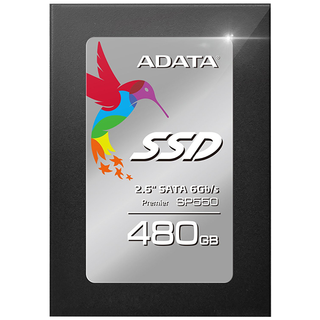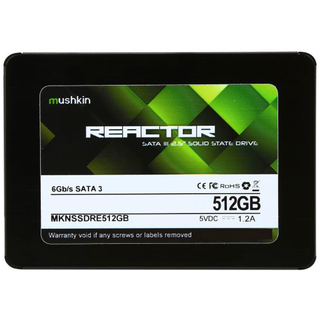Transcend SSD370S 512GB SSD Review
Transend's SSD370 we tested previously fell short of meeting our quality standards. But the SSD370S fixes those issues using Micron 16nm synchronous flash. Unfortunately, this model is also more expensive than its competition.
Why you can trust Tom's Hardware
Four-Corner Testing
Comparison Products
To read about our storage tests in-depth, please check out How We Test HDDs And SSDs. Four-corner testing is covered on page six of our How We Test guide.
Sequential Read


We're using entry-level and mid-range drives to compare against the SSD370S. This segment has seen a lot of activity lately with the addition of Crucial's BX200, Adata's SP550 and OCZ's Trion 100. All three SSDs join the Samsung 850 EVO as three-bit-per-cell-based contenders.
None of the drives in our chart have any problem reading back data sequentially. With deep command queues and large blocks, almost all of them hit the upper limits of SATA 6Gb/s. Transcend's SSD370S 512GB does appear at the bottom of the list in comparisons of two 128KB reads from the drives simultaneously.
Sequential Write


Sequential writes are more problematic, as three TLC-based drives struggle with inconsistent performance. They all rely heavily on small emulated SLC layers to mask the native behavior of TLC NAND. But those small caches only last for a few seconds before they're exhausted, exposing transfer rates averaging between 70 and 100 MB/s at this capacity point. Samsung's 850 EVO uses the same caching mechanism (branded TurboWrite), but its native TLC write performance is much higher.
The SSD370S falls in line with the other two SM2246EN-based drives. Its sequential write performance is consistent across the queue depth range.
Random Read
The SSD370S lands in the middle of the group in our 4KB random read test. At a queue depth of one, this drive ranks third on our list of low-cost SSDs, just behind the class-leading 850 EVO and recently-discontinued BX100.
Transcend's SSD also scales well through the queue depth range, peaking at just over 71,000 random read IOPS. Most enthusiasts don't exceed a queue depth of four though, even under heavy workloads.
Random Write



It's easier to encounter deep queues when you're working with random writes. From multi-tasking to installing software and performing other common tasks, it's certainly possible to feel the difference between these SSDs. Higher random write performance is also closely associated with lower latency between writes.
The three Silicon Motion-controlled drives again turn in nearly identical performance through the queue depth range. Their numbers far exceed the three TLC-based SSDs armed with Micron and Toshiba flash, but they all fail to match Samsung's 850 EVO.
Current page: Four-Corner Testing
Prev Page Specifications, Pricing, Warranty And Accessories Next Page Mixed Workload And Steady StateStay on the Cutting Edge
Join the experts who read Tom's Hardware for the inside track on enthusiast PC tech news — and have for over 25 years. We'll send breaking news and in-depth reviews of CPUs, GPUs, AI, maker hardware and more straight to your inbox.

Ryzen 9 7950X3D surfaces with 192MB L3 cache, 64MB more than retail CPU — may be an ES CPU or software detection error

Multi-million dollar Cheyenne supercomputer auction ends with $480,085 bid — buyer walked away with 8,064 Intel Xeon Broadwell CPUs, 313TB DDR4-2400 ECC RAM, and some water leaks

Mod turns ROG Ally into a modern-day Nintendo DS — the second screen also serves as a stand for the gaming handheld
-
Co BIY If the Crucial BX100 is no longer available I don't think it belongs in the performance comparison charts. Although I see the value for analyzing the trends in the market it doesn't reflect the current state and gives Crucial undeserved positive exposure for a product they can no longer even bring to market.Reply
Seems that value SSDs are one area where we are not getting continuous performance improvement but instead some backslide. -
CRamseyer The BX100 is far from an obsolete product since anyone can still purchase the series at Newegg, Amazon and a number of other online stores. I would even go as far as to say some are still on retail shelves. It is also a product that many people know and can use to compare performance against.Reply
I do agree with your comment on mainstream performance moving the wrong direction. It's a trend we will have to live with until Toshiba, Micron and SK Hynix move to 3D like Samsung. Micron appears to be the first with some 3D flash expected in June or July. 2D TLC will survive and make up the entry-level sector. 3D TLC and 3D MLC will account for the mainstream and performance sectors of the market. -
Tony37x Your pricing on the Samsung 850 EVO 500GB is very misleading - It's actually less than both of these in the article @ $149 NOT $270!!! No brainer, go with the top-rated Samsung :)Reply
http://www.amazon.com/gp/product/B00OBRE5UE/?tag=bom_tomshardware-20 -
jai_123 Do you suggest using SSD370 on a RAID 1 ? I am planning to create a RAID 1, not yet finalized to choose a OS based RAID or use a cheap HW RAID adapter.Reply -
CRamseyer With RAID 1 you don't have to worry about the Yahtzee effect. In my next RAID Report I'll explain it with some additional detail.Reply
Most SSDs will work fine in RAID 1. -
shaolin95 So for someone with a SATA II only system trying to extend the life of anotherwise powerful system, is the 850 EVO the best option?Reply



